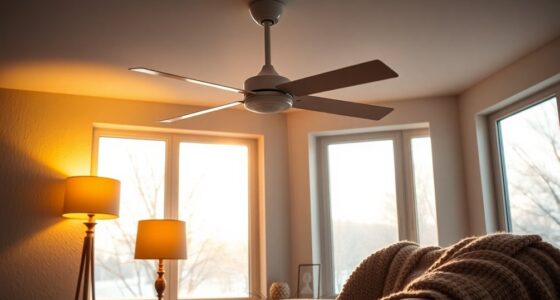A little ceiling fan wobble is normal, especially at high speeds, but it shouldn't be excessive. Minor wobbling usually results from slight vibrations and isn't a safety issue. However, factors like loose screws, dirt buildup, and improper installation can cause more noticeable wobble. Make certain your fan is securely mounted and the blades are clean and aligned. Also, keep at least 18 inches of clearance around the blades for safety. If wobble increases or you notice other issues, it might be time to consult an expert. There's more to guarantee your fan runs smoothly and safely.
Key Takeaways
- Minor wobble at high speeds is generally normal, but excessive wobble indicates potential issues needing attention.
- Regular maintenance, including cleaning and inspections, is crucial for minimizing wobble effects and ensuring safety.
- Ensure all components, including screws and brackets, are securely fastened to prevent imbalance and wobble.
- Maintain at least 18 inches of clearance around blades to enhance safety and performance during operation.
- If wobbling persists despite DIY adjustments, seek professional help to address potential structural or installation issues.
Normal Wobble Explained
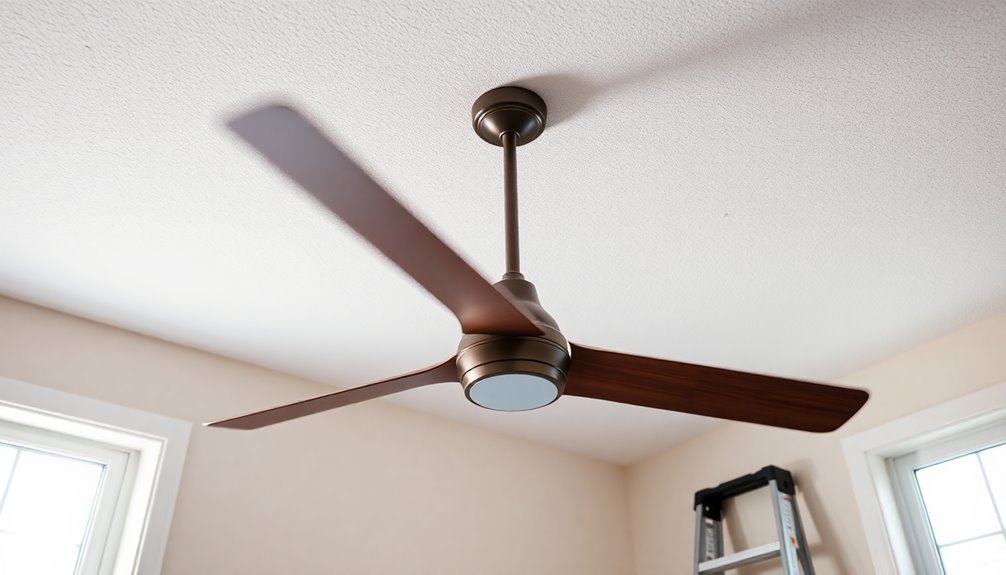
While you might notice a slight wobble when your ceiling fan is running at high speeds, it's usually nothing to worry about.
This minor wobble often results from high-speed operation, which can cause slight vibrations. You'll likely only notice it when the fan is on its highest setting, and it typically doesn't pose any safety issues. Factors such as blade size, weight, and installation quality can influence how much wobble you see. Regular maintenance can also help minimize it. Ensuring that the fan is installed correctly and that all mounting hardware is secure will greatly reduce wobbling. Additionally, modern Energy Star certified fans are designed to operate more efficiently, potentially reducing wobble during high-speed use.
If you keep an eye on your fan's performance and verify it's properly installed, you can enjoy its cooling benefits without concern. Just remember, a little wobble is often perfectly normal.
Reasons for Ceiling Fan Wobble

Ceiling fan wobble can often be traced back to a few common issues. You might find loose components, dirt accumulation, or warped blades causing the imbalance. Identifying these problems early can help you maintain a smooth and safe operation. Wobbling is primarily caused by an imbalance in the fan, which highlights the importance of regular inspections and maintenance to ensure all components are secure and functioning properly.
Loose Components
One of the main reasons for ceiling fan wobble is loose components. It's essential to check for loose screws on the blades, motor, and mounting plate. Tightening these can greatly reduce wobble. Similarly, verify the mounting bracket is securely fastened to the electrical box. A faulty installation can also lead to imbalance, so confirm that the fan is correctly mounted. Electrical box positioning must be flush with the ceiling to ensure proper support and reduce wobbling. Here's a quick reference table to help you identify common loose component issues:
| Component | Potential Issue | Solution |
|---|---|---|
| Screws | Loose screws cause wobble | Tighten all screws securely |
| Mounting Bracket | Improperly secured bracket | Secure bracket to the ceiling |
| Installation Quality | Incorrect fan mounting | Consult a professional if needed |
Taking these steps can help keep your ceiling fan running smoothly and safely.
Dirt Accumulation
After ensuring all components are secure, it's important to reflect on dirt accumulation as another significant factor contributing to ceiling fan wobble.
Here are three key points to take into account:
- Dust and Grime Buildup: Dust on one side of the blades can create an imbalance, leading to wobbling.
- Blade Vibration: Accumulated dirt causes the blades to vibrate during operation, worsening the wobble. Additionally, regular maintenance of the fan can help sustain its performance and prevent wobbling.
- Safety Hazard: Continuous wobbling due to dirt can loosen parts, posing a risk of falling components. To further prevent wobbling, regularly remove dust from fan blades to maintain balance.
To prevent these issues, regularly inspect and clean your ceiling fan, focusing on both the blades and motor.
Use a soft microfiber cloth or vacuum to maintain ideal performance and longevity, ensuring your fan operates smoothly and safely.
Warped Blades
Warped blades can greatly disrupt your ceiling fan's performance, leading to wobbling and noise. Several factors can cause warping, like accidental bumps, prolonged residue build-up, and high humidity. Loose screws and poor craftsmanship in low-quality fans can also contribute. When blades warp, they create an imbalance, resulting in annoying squeaks and potential motor damage.
To identify warped blades, visually inspect them for curvature and measure their spacing from the ceiling. Lay each blade flat to check for warping and verify all attachments are secure. Loose blade screws can also exacerbate the issue, making it essential to ensure they are tightened properly.
If you find damaged blades, consider replacing them or using a balancing kit. Tightening screws and lubricating moving parts can also help maintain your fan's stability and efficiency.
How to Troubleshoot Wobble
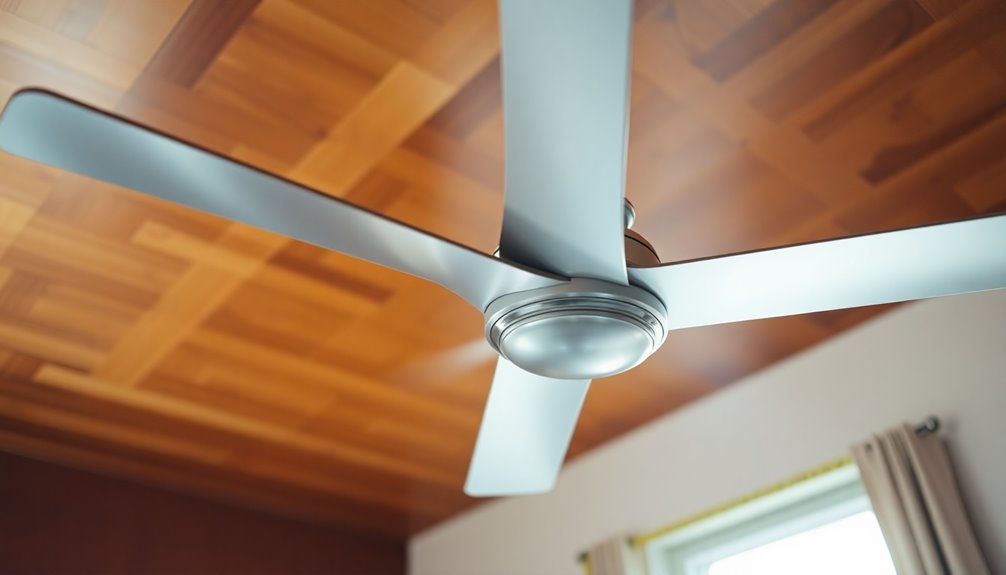
To troubleshoot a wobbling ceiling fan, start by identifying the source of the issue.
Check the blade connections to verify they're tight and secure, and don't forget to clean the blades regularly to maintain balance. Regular maintenance enhances fan longevity and performance. A little maintenance can go a long way in keeping your fan running smoothly.
Identify Wobble Source
Identifying the source of a ceiling fan wobble is essential for guaranteeing safety and performance.
Start by checking these common issues:
- Loose Screws and Mounting Hardware: Guarantee all screws, including those on the blades and mounting bracket, are tight.
- Unbalanced Fan Blades: Inspect for mismatched weights, warping, or uneven spacing among the blades. Excessive wobble can indicate that there may be deeper installation or structural issues to address.
- Improper Installation: Verify that the ceiling box and hanging bracket are securely attached and aligned.
Check Blade Connections
Check your blade connections to eliminate wobble and guarantee your ceiling fan operates smoothly.
Start by tightening all screws that attach the blades to the blade holder. Make sure the blade holders are firmly fixed to the fan flywheel and check for any signs of warping. Use a ruler to measure the distance between each blade and the ceiling, ensuring they're evenly spaced. If needed, adjust the blade holder to align the blades properly. Additionally, it's important to inspect motor for obstructions that may impede movement, as this can also contribute to wobble.
Next, inspect the mounting screws and bracket, ensuring everything is secure and fastened to the ceiling. Don't forget to check the downrod and light fixture screws.
Addressing these connections can greatly reduce wobble and enhance your fan's performance.
Clean and Maintain Blades
After confirming your blade connections are secure, it's time to focus on cleaning and maintaining the blades to further reduce wobble.
Regular maintenance can remarkably enhance your ceiling fan's performance. Here are three essential tips:
- Dust Removal: Use a cloth or an old pillowcase to gently wipe the blades, capturing dust without heavy pressure.
- Blade Cleaning: Apply an all-purpose cleaner or a vinegar-water solution on a damp cloth to clean each blade. Confirm they dry completely to prevent attracting more dust. Regular dusting can also enhance fan efficiency. Additionally, ensuring your fan is properly balanced can significantly improve its overall performance.
- Blade Balance: Inspect for dirt accumulation and confirm even weight distribution. If necessary, use balancing weights to stabilize the blades.
Balancing Your Ceiling Fan
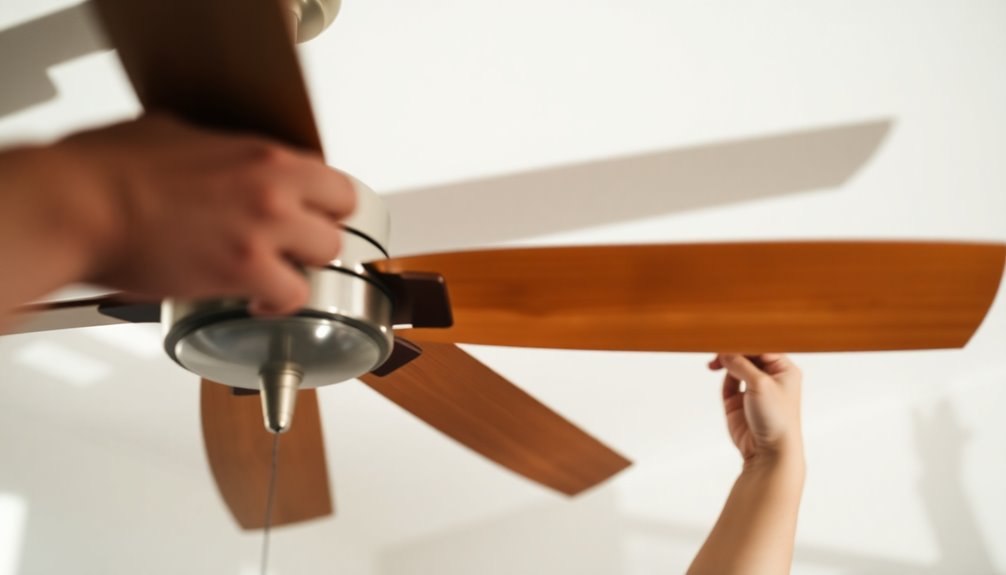
Balancing your ceiling fan is essential for smooth operation and safety. Start by identifying the causes of wobble, like loose screws, dust accumulation, warped blades, or misaligned blade holders. Additionally, addressing imbalanced fan blades can significantly improve performance.
To balance your fan, first, turn it off and clean each blade thoroughly. Then, check blade alignment with a yardstick to verify they're all at the same height. Tighten any loose screws and gently adjust bent blade holders.
Once you've made these adjustments, run the fan to see if the wobble persists. If needed, use a balancing kit by placing a clip on the wobbly blade and testing its position. Repeat this process for all blades until the wobble is eliminated.
Essential Safety Precautions
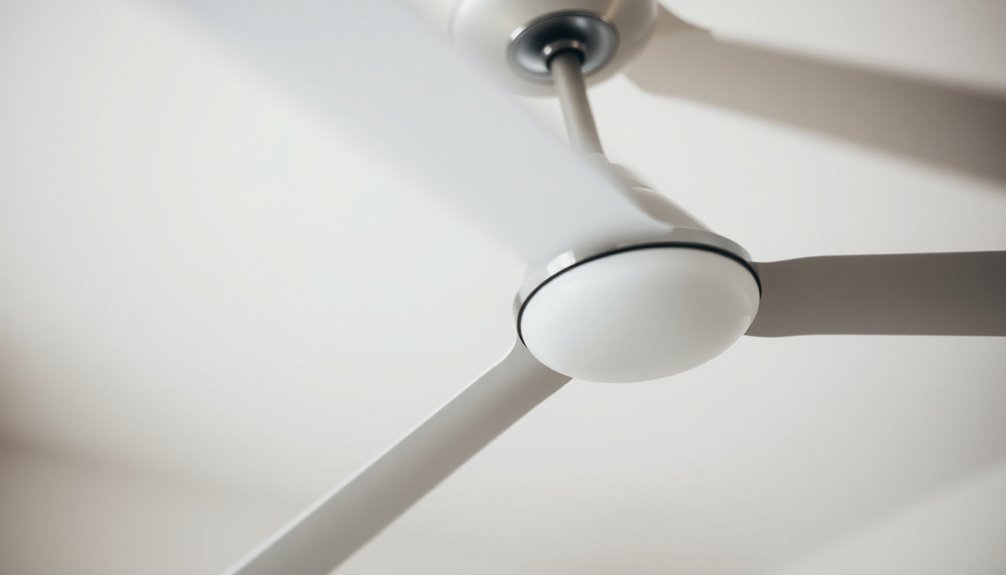
Ensuring your ceiling fan operates safely goes hand-in-hand with proper balancing. To keep your fan in top shape, follow these essential safety precautions:
- Proper Installation: Make sure it's securely mounted to a fan-rated junction box by a qualified electrician. Improper installation can lead to wobbling or even falling of the fan.
- Regular Maintenance: Inspect for loose screws or worn parts regularly, and clean the blades to prevent buildup. Schedule maintenance checks at least twice a year to ensure everything is in optimal condition.
- Safe Operation: Maintain at least 18 inches of clearance around the blades and use appropriate speed settings for the season. Always turn off the fan before cleaning or maintenance to ensure safety.
Additional Safety Guidelines
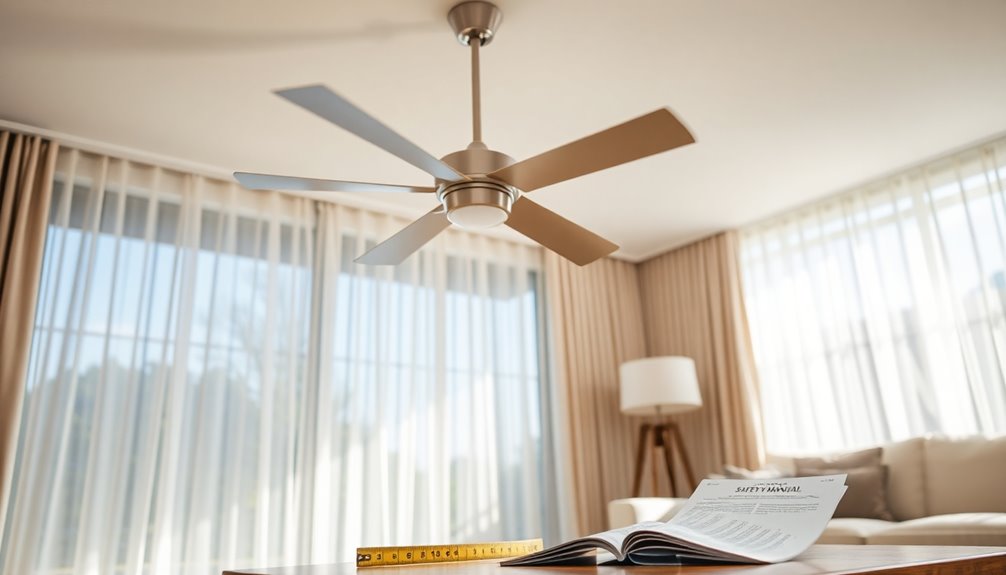
While maintaining your ceiling fan, it's crucial to keep additional safety guidelines in mind to prevent wobbling and guarantee its longevity.
First, install your fan away from windows to avoid strong winds. Regularly clean the blades and body to prevent dust build-up that can strain the motor. Balanced fans operate quietly and efficiently, reducing wear and tear on motor components.
Avoid overloading your fan with heavy accessories and secure any dangling items that could cause imbalance. Check blade connections and inspect for bent or damaged parts. Lubricate moving components as per the manufacturer's instructions. Ascertain the electrical box and mounting bracket are securely fastened.
Finally, use a blade-balancing kit if needed and replace any damaged parts promptly to maintain safety and performance.
When to Call an Expert
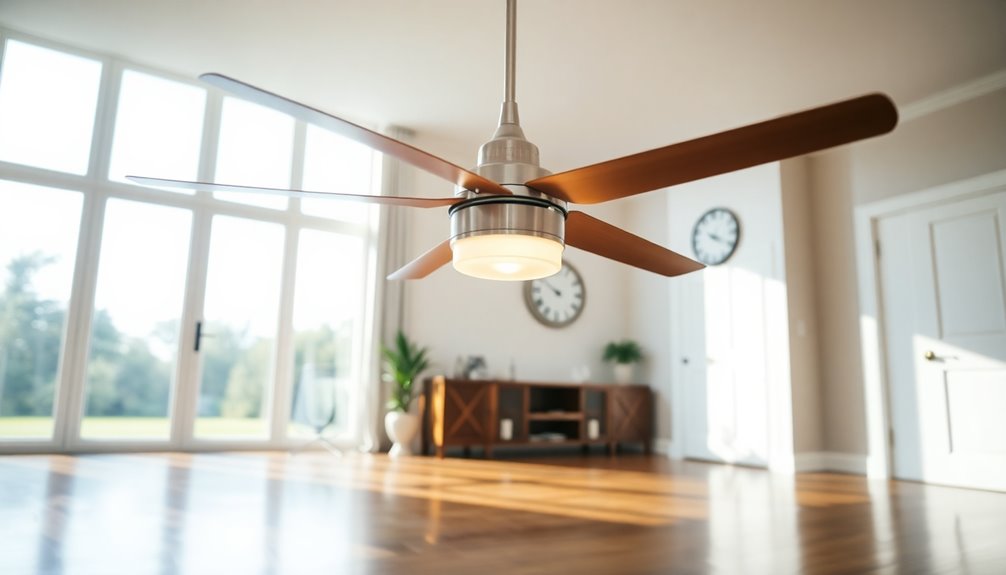
Even with proper maintenance, you might encounter issues that require professional help.
If your ceiling fan wobbles excessively, it's essential to recognize when to call an expert. Consider these situations:
- Loose Connections: If you notice loose screws or joints that you can't tighten, it's time for a pro.
- Unbalanced Blades: Uneven spacing or blades of different sizes can cause imbalance that could lead to damage.
- Structural Issues: A loose mounting bracket or damaged ceiling box can jeopardize safety and stability. Additionally, insufficient support from the electrical box can lead to shaking, making it crucial to address any underlying issues.
Don't ignore any significant wobbling.
These problems can pose safety risks or lead to further damage if left unaddressed.
When in doubt, reaching out to a professional guarantees your ceiling fan operates safely and efficiently.
Frequently Asked Questions
How Can I Tell if My Fan Is Unbalanced?
To tell if your fan is unbalanced, start by inspecting the blades for loose screws and brackets. Tighten any that are loose to guarantee they're secure.
Next, check for dust buildup, as uneven dust can cause imbalance.
Look for warped or damaged blades by laying them flat.
Finally, confirm that the blade holders are aligned and snug against the ceiling.
Regular maintenance will help keep your fan running smoothly.
What Tools Do I Need to Fix a Wobbly Fan?
Think of fixing a wobbly fan like tuning a guitar; every string needs to be just right.
To get your fan balanced, you'll need a few tools. Grab a Phillips-head screwdriver to tighten screws, a stepladder for reach, and clear tape or coins to add weight for balance.
A yardstick helps measure blade height, while a duster keeps everything clean.
With these tools, you'll have your fan spinning smoothly in no time!
Is It Safe to Run a Wobbly Ceiling Fan?
Running a wobbly ceiling fan isn't safe. It can fall, causing injury or damage to your property.
Wobbly blades increase the risk of cuts and can lead to motor damage, resulting in annoying noises and reduced performance.
Plus, loose connections might create electrical hazards. If your fan wobbles, it's best to address the issue promptly.
Check for loose parts, balance the blades, or consider seeking professional help if needed.
Can Humidity Affect Ceiling Fan Wobble?
Yes, humidity can definitely affect ceiling fan wobble. High moisture levels can warp poorly made fan blades, leading to imbalance and wobble.
If you notice your fan wobbling more in humid conditions, check the blade alignment and clean off any dust.
How Often Should I Check My Ceiling Fan for Wobble?
Think of your ceiling fan like a trusty steed; it needs regular care to keep galloping smoothly.
You should check it for wobble at least once a month, but don't neglect daily inspections for loose screws or damage.
A weekly dusting keeps it light on its feet, while quarterly lubrication guarantees it runs like a dream.
If you notice any issues, schedule an annual check-up with a professional to keep everything in tip-top shape.
Conclusion
So, if your ceiling fan sways like it's auditioning for a dance-off, don't panic—some wobble is totally normal. Just remember, if your fan starts to resemble a wild carnival ride, it's time to take action. Tighten those screws, balance those blades, and maybe skip the interpretive dance routine underneath. And if it's still wobbling like it's got a mind of its own, don't hesitate to call in the pros—unless you want a fan that moonlights as a ceiling decoration!




